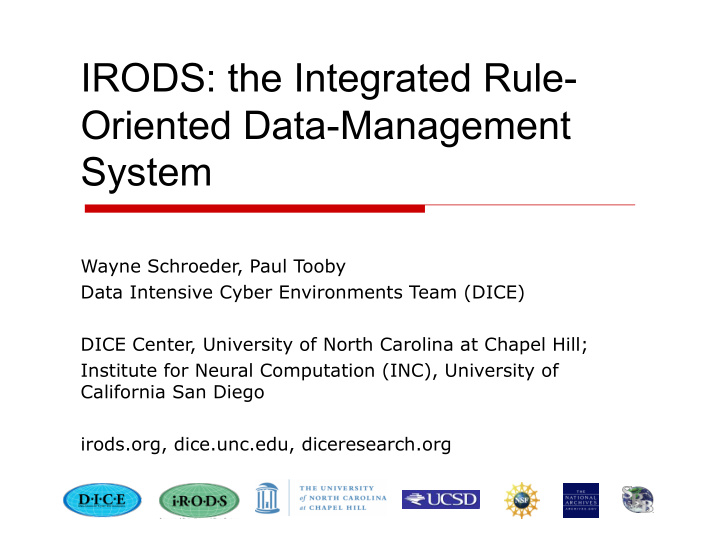



IRODS: the Integrated Rule- Oriented Data-Management System Wayne Schroeder, Paul Tooby Data Intensive Cyber Environments Team (DICE) DICE Center, University of North Carolina at Chapel Hill; Institute for Neural Computation (INC), University of California San Diego irods.org, dice.unc.edu, diceresearch.org
Who Are We? Computer Scientists and Software Engineers Started in 1997 Grew out of High Performance Computing • Broadened support to Digital Libraries/Preservation Doing applied research • Digital Preservation and Data-Grids Develop and distribute Integrated Rule-Oriented Data System (iRODS) • Open Source; PCs to High-Performance Computing
What Problems Are We Solving? Researchers may have millions of computer files Keep them safely stored and replicated (remotely) Distribute them across the network; remote access Automate handling; rules, work-flows Keep track of what they are (meta-data) Be able to find the right ones quickly (queries) Share them, in a controlled manner (authentication, access control, audit trails) Preserve them; change storage transparently
Data Management Applications • Data grids – Build shareable collection • Processing pipelines – Apply standard procedures on files • Digital Libraries – Publish data collections • Preservation Environments – Ensure properties of a collection – Migrate collections to new technology • Federation – Build collection that spans multiple data grids
What Does iRODS Do? (1 of 3) Remote High-Performance Data Access get/put, read/write Encapsulate small message in request to send Parallel threads for large transfers with TCP/IP Reliable Blast UDP Unified View Of Disparate Data Organizes distributed data into a shareable collection Separates physical from logical (logical name-space) Keeps track of names and locations of files Storage System Independent Unix/Windows File Systems HPSS (Archival Storage) Universal mass storage system interface
What Does iRODS Do? (2 of 3) Replication/Backup Physical copies Metadata (RDBMS) System and user-defined PostgreSQL, Oracle, MySQL Queries/Information Discovery Access Control users/groups Secure Passwords, Grid Security Infrastructure (GSI), Kerberos, Shibboleth soon
What Does iRODS Do? (3 of 3) Policies / computer actionable rules Highly configurable Enforce management policies Automate administrative functions Validate assessment criteria Workflows Rules/Micro-services (immediate, delayed, periodic) Management of Large Collections irsync - synchronize remote directory into the data grid Audit trails Descriptive metadata - extensible schema
Sharing Data in iRODS Data System Scientist B Scientist A Accesses and Adds data to analyzes shared Shared Collection Data iRODS Data System iRODS Brain Data Audio Data Video Data Metadata Server, CA Server, NJ Server, TN Catalog Scientists can use iRODS as a “data grid” to share multiple types of data, near and far. iRODS Rules also enforce and audit human subjects access restrictions.
DICE Technologies Helping UCSD Projects The National Center for Microscopy and Imaging Research (NCMIR) is using DICE SRB and testing iRODS in the Cell Centered Database project. DICE iRODS helps computational seismologists from the Southern California Earthquake Center (SCEC) manage large-scale earthquake simulation data at SDSC and other TeraGrid sites. UCSD Libraries Digital Asset Management System (DAMS) using DICE technologies, including SRB. DICE iRODS helps Ocean Observatories Initiative (OOI) with Scripps and Calit2 manage large-scale diverse ocean data, including real-time streaming data. And others including CineGrid , TDLC , etc.
Connecting Data Collections for New Science "Federating" isolated "silos" of data enables new collaborations OOI ocean data flows in iRODS data grid to NOAA National Climatic Data Center (NCDC) NCDC climate data is accessed through data grid for CUAHSI hydrology research on floods CUAHSI hydrology data connects to Odom Institute for social science research on human impacts and response to floods OOI climate data discovered and flows to iPlant Consortium for designing drought-resistant plants for climate change adaptation
Growing Use of iRODS Data System Astronomy : NOAO, NVO, Observatoire de Strasbourg, France; CADAC, etc. Geo : NOAA NCDC; OOI; SCEC, etc. HPC : TeraGrid sites, SDSC, TACC, NICS, etc. NASA NCCS Bio : TDLC, NICMIR, iPlant, etc. Preservation : NARA TPAP, French National Library; Texas Digital Library; Fedora Commons; Dspace, etc. Workflow: Kepler, Taverna, etc. International : EU SHAMAN; Australian ARCS; UK e-Science; KEK (Japan); Academica Sinica (Taiwan); CC-IN2P3 HEP, France; etc. Industry : IBM, Oracle/Sun, Atos Origin, Microsoft, DataDirect
DICE Team Data Intensive Cyber Environments Center University of North Carolina at Chapel Hill (UNC) UNC School of Information and Library Science (SILS) Renaissance Computing Institute (RENCI) Reagan Moore (Professor) Arcot Rajasekar (Professor) Antoine de Torcy, Chien-Yi Hou, Mike Conway UC San Diego Institute for Neural Computation (INC) Mike Wan Wayne Schroeder Sheau-Yen Chen, Bing Zhu, Paul Tooby iRODS development is supported by NSF OCI-0848296 "NARA Transcontinental Persistent Archives Prototype" (2008-2012) NSF SDCI 0721400 "Data Grids for Community Driven Applications" (2007-2010)
Recommend
More recommend